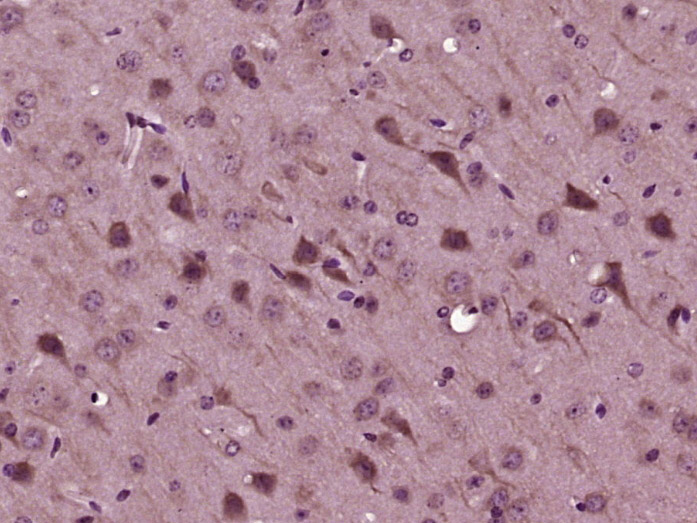SRPK2 Rabbit pAb
SRPK2 Rabbit pAb
- 产品详情
- 实验流程
- 背景知识
Application
| IHC-P, IHC-F, IF |
|---|---|
| Primary Accession | P78362 |
| Reactivity | Human, Mouse |
| Predicted | Rat, Chicken, Dog, Pig, Horse, Rabbit, Sheep |
| Host | Rabbit |
| Clonality | Polyclonal |
| Calculated MW | 77527 Da |
| Physical State | Liquid |
| Immunogen | KLH conjugated synthetic peptide derived from human SRPK2 |
| Epitope Specificity | 266-350/688 |
| Isotype | IgG |
| Purity | affinity purified by Protein A |
| Buffer | 0.01M TBS (pH7.4) with 1% BSA, 0.02% Proclin300 and 50% Glycerol. |
| SUBCELLULAR LOCATION | Cytoplasm. Nucleus. Note=Shuttles between the nucleus and the cytoplasm. KAT5/TIP60 inhibits its nuclear translocation. Phosphorylation at Thr-492 by PKB/AKT1 promotes nuclear translocation. |
| SIMILARITY | Phosphorylation at Thr-492 by PKB/AKT1 enhances its stimulatory activity in triggering cyclin-D1 (CCND1) expression and promoting apoptosis in neurons, which can be blocked by YWHAB. It also enhances its protein kinase activity toward ACIN1 and SRSF2, promotes its nuclear translocation and prevents its proteolytic cleavage. Belongs to the protein kinase superfamily. CMGC Ser/Thr protein kinase family.Contains 1 protein kinase domain. |
| SUBUNIT | Interacts with PKB/AKT1 in a phosphorylation-dependent manner. The phosphorylated form (by PKB/AKT1) interacts with YWHAB and YWHAE. Interaction with YWHAB suppresses its cleavage by caspases and inhibits the release of its N-terminal pro-apoptotic fragment. Interacts with SFN. Associates with U4/U6-U5 tri-small nuclear ribonucleoproteins (U4/U6-U5 tri-snRNPs). |
| Post-translational modifications | Proteolytically cleaved at Asp-139 and Asp-403 by caspase-3 during apoptotic cell death. Cleavage at Asp-139 which is the major site of cleavage, produces a small N-terminal fragment that translocates into nucleus and promotes VP16-induced apoptosis. |
| Important Note | This product as supplied is intended for research use only, not for use in human, therapeutic or diagnostic applications. |
| Background Descriptions | SRPK2 belongs to the protein kinase superfamily. It phosphorylates RS domain-containing proteins, such as SFRS1 and SFRS2 on serine residues. It has a role in spliceosome assembly and in mediating the trafficking of splicing factors and appears to mediate HBV core protein phosphorylation which is a prerequisite for pregenomic RNA encapsidation into viral capsids. SRPK2 highly expressed in brain, moderately expressed in heart and skeletal muscle and at low levels in lung, liver, and kidney. |
| Gene ID | 6733 |
|---|---|
| Other Names | SRSF protein kinase 2, 2.7.11.1, SFRS protein kinase 2, Serine/arginine-rich protein-specific kinase 2, SR-protein-specific kinase 2, SRSF protein kinase 2 N-terminal, SRSF protein kinase 2 C-terminal, SRPK2 {ECO:0000312|EMBL:AAH68547.1} |
| Target/Specificity | Highly expressed in brain, moderately expressed in heart and skeletal muscle and at low levels in lung, liver, and kidney. |
| Dilution | IHC-P=1:100-500,IHC-F=1:100-500,IF=1:100-500 |
| Storage | Store at -20 °C for one year. Avoid repeated freeze/thaw cycles. When reconstituted in sterile pH 7.4 0.01M PBS or diluent of antibody the antibody is stable for at least two weeks at 2-4 °C. |
| Name | SRPK2 {ECO:0000312|EMBL:AAH68547.1} |
|---|---|
| Function | Serine/arginine-rich protein-specific kinase which specifically phosphorylates its substrates at serine residues located in regions rich in arginine/serine dipeptides, known as RS domains and is involved in the phosphorylation of SR splicing factors and the regulation of splicing (PubMed:18559500, PubMed:21056976, PubMed:9472028). Promotes neuronal apoptosis by up-regulating cyclin-D1 (CCND1) expression (PubMed:19592491). This is done by the phosphorylation of SRSF2, leading to the suppression of p53/TP53 phosphorylation thereby relieving the repressive effect of p53/TP53 on cyclin-D1 (CCND1) expression (PubMed:21205200). Phosphorylates ACIN1, and redistributes it from the nuclear speckles to the nucleoplasm, resulting in cyclin A1 but not cyclin A2 up-regulation (PubMed:18559500). Plays an essential role in spliceosomal B complex formation via the phosphorylation of DDX23/PRP28 (PubMed:18425142). Probably by phosphorylating DDX23, leads to the suppression of incorrect R-loops formed during transcription; R-loops are composed of a DNA:RNA hybrid and the associated non-template single-stranded DNA (PubMed:28076779). Can mediate hepatitis B virus (HBV) core protein phosphorylation (PubMed:12134018). Plays a negative role in the regulation of HBV replication through a mechanism not involving the phosphorylation of the core protein but by reducing the packaging efficiency of the pregenomic RNA (pgRNA) without affecting the formation of the viral core particles (PubMed:16122776). |
| Cellular Location | Cytoplasm. Nucleus, nucleoplasm. Nucleus speckle. Chromosome. Note=Shuttles between the nucleus and the cytoplasm (PubMed:19592491, PubMed:21056976, PubMed:21157427) KAT5/TIP60 inhibits its nuclear translocation (PubMed:21157427) Phosphorylation at Thr-492 by PKB/AKT1 promotes nuclear translocation (PubMed:19592491). Preferentially localizes across the entire gene coding region (PubMed:28076779). During transcription, accumulates at chromatin loci where unscheduled R-loops form and colocalizes with paused 'Ser-5'-phosphorylated POLR2A/RNA polymerase II and helicase DDX23 (PubMed:28076779). |
| Tissue Location | Highly expressed in brain, moderately expressed in heart and skeletal muscle and at low levels in lung, liver, and kidney |
For Research Use Only. Not For Use In Diagnostic Procedures.
Provided below are standard protocols that you may find useful for product applications.
BACKGROUND
SRPK2 belongs to the protein kinase superfamily. It phosphorylates RS domain-containing proteins, such as SFRS1 and SFRS2 on serine residues. It has a role in spliceosome assembly and in mediating the trafficking of splicing factors and appears to mediate HBV core protein phosphorylation which is a prerequisite for pregenomic RNA encapsidation into viral capsids. SRPK2 highly expressed in brain, moderately expressed in heart and skeletal muscle and at low levels in lung, liver, and kidney.
终于等到您。ABCEPTA(百远生物)抗体产品。
点击下方“我要评价 ”按钮提交您的反馈信息,您的反馈和评价是我们最宝贵的财富之一,
我们将在1-3个工作日内处理您的反馈信息。
如有疑问,联系:0512-88856768 tech-china@abcepta.com.























 癌症的基本特征包括细胞增殖、血管生成、迁移、凋亡逃避机制和细胞永生等。找到癌症发生过程中这些通路的关键标记物和对应的抗体用于检测至关重要。
癌症的基本特征包括细胞增殖、血管生成、迁移、凋亡逃避机制和细胞永生等。找到癌症发生过程中这些通路的关键标记物和对应的抗体用于检测至关重要。 为您推荐一个泛素化位点预测神器——泛素化分析工具,可以为您的蛋白的泛素化位点作出预测和评分。
为您推荐一个泛素化位点预测神器——泛素化分析工具,可以为您的蛋白的泛素化位点作出预测和评分。 细胞自噬受体图形绘图工具为你的蛋白的细胞受体结合位点作出预测和评分,识别结合到自噬通路中的蛋白是非常重要的,便于让我们理解自噬在正常生理、病理过程中的作用,如发育、细胞分化、神经退化性疾病、压力条件下、感染和癌症。
细胞自噬受体图形绘图工具为你的蛋白的细胞受体结合位点作出预测和评分,识别结合到自噬通路中的蛋白是非常重要的,便于让我们理解自噬在正常生理、病理过程中的作用,如发育、细胞分化、神经退化性疾病、压力条件下、感染和癌症。






